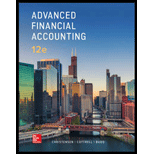
a
Consolidation income tax issues: The legal structure of an acquisition can result in taxable or non-taxable transactions. In taxable transaction, the assets acquired and liabilities assumed will have tax basis equal to the fair market values because the subsidiary is required to recognize all inherent gains and losses for tax purposes. In order to avoid this, many acquisitions are structured to avoid classification as taxable transaction.
Any difference arising out of fair market value and tax basis should be recorded as
When companies in the consolidated group files separate tax returns, intercompany income accruals and dividend transfers must be considered in computing income tax expense for the period. When an investor and investee files separate tax returns, the investor is taxed on the dividends received from the investee rather than on the amount of investment income reported.
the
b
Consolidation income tax issues: The legal structure of an acquisition can result in taxable or non-taxable transactions. In taxable transaction, the assets acquired and liabilities assumed will have tax basis equal to the fair market values because the subsidiary is required to recognize all inherent gains and losses for tax purposes. In order to avoid this, many acquisitions are structured to avoid classification as taxable transaction.
Any difference arising out of fair market value and tax basis should be recorded as
When companies in the consolidated group files separate tax returns, intercompany income accruals and dividend transfers must be considered in computing income tax expense for the period. When an investor and investee files separate tax returns, the investor is taxed on the dividends received from the investee rather than on the amount of investment income reported.
the computation of income assigned to non-controlling interest for the year 20X5.
c
Consolidation income tax issues: The legal structure of an acquisition can result in taxable or non-taxable transactions. In taxable transaction, the assets acquired and liabilities assumed will have tax basis equal to the fair market values because the subsidiary is required to recognize all inherent gains and losses for tax purposes. In order to avoid this, many acquisitions are structured to avoid classification as taxable transaction.
Any difference arising out of fair market value and tax basis should be recorded as
When companies in the consolidated group files separate tax returns, intercompany income accruals and dividend transfers must be considered in computing income tax expense for the period. When an investor and investee files separate tax returns, the investor is taxed on the dividends received from the investee rather than on the amount of investment income reported.
the computation of income to controlling interest for 20X5.
d
Consolidation income tax issues: The legal structure of an acquisition can result in taxable or non-taxable transactions. In taxable transaction, the assets acquired and liabilities assumed will have tax basis equal to the fair market values because the subsidiary is required to recognize all inherent gains and losses for tax purposes. In order to avoid this, many acquisitions are structured to avoid classification as taxable transaction.
Any difference arising out of fair market value and tax basis should be recorded as deferred tax asset or liability.
When companies in the consolidated group files separate tax returns, intercompany income accruals and dividend transfers must be considered in computing income tax expense for the period. When an investor and investee files separate tax returns, the investor is taxed on the dividends received from the investee rather than on the amount of investment income reported.
Requirement 4
the computation of amount assigned to non-controlling interest in consolidated
Want to see the full answer?
Check out a sample textbook solution
Chapter 10 Solutions
Advanced Financial Accounting
 Cornerstones of Financial AccountingAccountingISBN:9781337690881Author:Jay Rich, Jeff JonesPublisher:Cengage Learning
Cornerstones of Financial AccountingAccountingISBN:9781337690881Author:Jay Rich, Jeff JonesPublisher:Cengage Learning Intermediate Accounting: Reporting And AnalysisAccountingISBN:9781337788281Author:James M. Wahlen, Jefferson P. Jones, Donald PagachPublisher:Cengage Learning
Intermediate Accounting: Reporting And AnalysisAccountingISBN:9781337788281Author:James M. Wahlen, Jefferson P. Jones, Donald PagachPublisher:Cengage Learning



